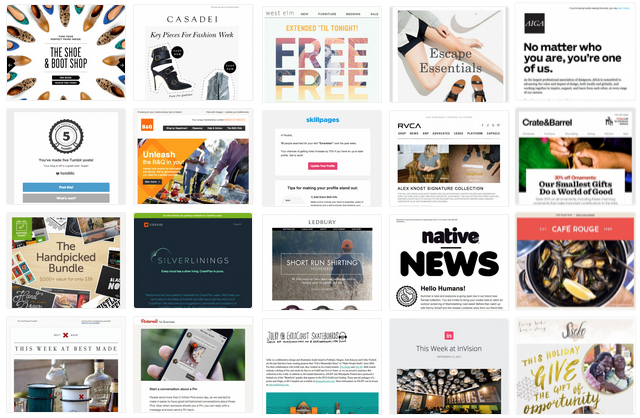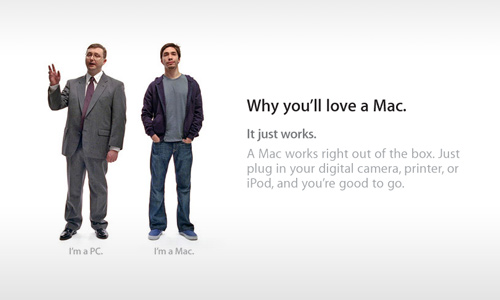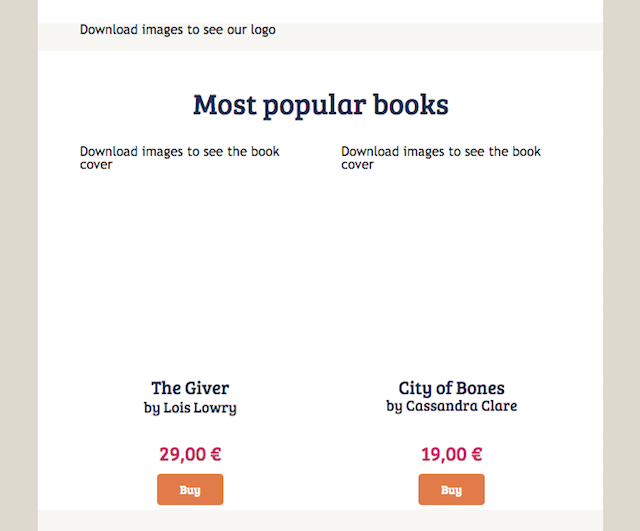How to create content for email campaigns
Back to list of guides
1
Chapter
How do we read online content?
Chapter
Writing Internet content (including emails and newsletters) has become an art. Simply writing something is not enough because the visual appeal of the text is often more important than what it actually says. The days when few people wrote and many people read are long gone. Now it’s the other way around.

Writing competition
The internet is full of content. Authors are constantly under pressure to come up with ideas for new articles and good advice. Everybody says that content is king but content is one thing and a well-formatted text is another.
Unfortunately, writing competitions for the most widely read e-content are usually won by pieces which:
- are short
- are divided into sections
- include graphics
- are written in bold font
- are bullet-pointed
The sad truth is that lengthy texts, even those with substance but not visually attractive, usually lose the race at the very beginning. Few Internet users have enough patience to read a text which is written in a single paragraph.
The scanning age
Today most online content is scanned by readers than read. Few people approach reading online text as they would a good book. We sift through a large number of articles, we scan bullet points, paragraphs, titles and graphs. If an article seems interesting we then read the whole thing. If not, we close the browser tab.
So this means that you have about 3 or 4 seconds to convince your reader that staying with you is worthwhile. And you have even less time, maybe a second or two, to make a good impression on the person receiving your email.

Source: wwwAdres internetowyAadres strony internetowej, na który zostanie przeniesiony użytkownik po jego kliknięciu lub wpisaniu w pasek adresu przeglądarki. Zwykle jest wyróżniony w tekście poprzez inny kolor i styl. Składa się zazwyczaj z protokołu (najczęściej http:// lub https:// dla zabezpieczonych stron), hosta/domeny (np. app.freshmail.pl) oraz z opcjonalnej ścieżki (np. /logowanie), np. http://app.freshmail/logowanie .e-t-r-a.org
What does the eye catch?
Making content attractive for a scanning audience means that it has to:
- have an intriguing title. The decision to click a link to an article or open an email is mostly influenced by the title.
- begin with a thesis and end with supporting arguments. First we read the lead, the first paragraph, and then we make the decision to read further.
- have section titles that should attract the reader, but at the same time they must be substantial and concise. It’s better if they include a conclusion drawn from the section that they open.
- contain graphic illustrations related to the content. When eyes get tired of reading they will gladly rest on an illustration.
- use bullet points, bold text and emphasis since these elements make sections of text look more valuable.
Anything that makes the reader more interested in reading your content is worth including. But remember not to overwhelm the point of the article and make it a triumph of form over substance. Otherwise the eye will initially be tricked but the readers will soon realize that something is missing.
In order to learn more about what the eye can see and what the reader remembers take a look at our article about eye tracking research.
2
Chapter
Content is king!
Chapter
In Chapter 1 you learned how to use certain tricks to convince the reader’s eye to continue to focus on the text. But email marketing is guided by a different set of rules than web writing and you should actually keep both sets in mind. There are several golden rules which should not be ignored.

What is content marketing?
As the name implies, it’s using content for promotional purposes. More precisely, it is a kind of marketing where you don’t only use empty slogans, prices and offers. It is a strategy of gaining market share through distribution of interesting and useful content. The purpose is to present the company as an expert who willingly shares knowledge.
A company that follows this strategy cannot sell everything thing to everyone. It is more important to reach a precise target group with knowledge in a given field, so that the reader wants to buy it and feels like they’re dealing with an expert.
What’s also important is that communication through content marketing isn’t only based on single marketing “shots in the dark”, but on a durable relationship with the reader that doesn’t stop as long as content is supplied regularly.
What is content?
Content is any information, which provides your reader with new, valuable knowledge. This can be things like:
- guides
- success stories
- video guides
- tutorials
- how to's
- good practices
- infographics
But it can also be “added value” from the offline world, such as:
- courses
- conferences
- books
- printed magazines

Valuable content, got any?
Before you start working on creating an email campaign or a newsletter, you should ask yourself one important question:
So what valuable content do you have?
- If your answer is “None”, think again. What would you like to communicate to your audience using your emails and what do you have to offer?
- If the answer is “Lots!”, it means you are in the right place at the right time.
3
Chapter
How to create good emails and newsletters
Chapter
When creating email campaigns it is very important to look through the eyes of your audience with what they want to buy in mind and not just with what the marketer wants to sell. Unfortunately this important point is often forgotten. Therefore, regardless of how often you create email campaigns, it is always worthwhile to ask yourself a few questions.

How would you like to be seen?
Before sending the first email, think how you would like your audience to see you. This should be reflected in the style of communication you use - whether you use colloquial forms and first names or begin with “Dear Mr./ Dear Mrs.” And if the style of your entire communication is more formal or a bit more laid back, this can take on more meaning later on.
Email marketing is a sort of direct communication, so a less formal approach is recommended, although much depends on the industry and the kind of people that you’re dealing with.
What do you want to communicate?
Every email campaign should be guided by some kind of theme. You can’t just write about everything, there has to be a purpose, a big idea, a concept. Otherwise the audience will sense the chaos in your message.
A tagline should provide style to the entire creation. If you try to say it all, you might end up saying nothing at all. So, decide on one specific message and write it down so as not to lose sight of it later on in the creative process.
It makes sense to ask yourself what you want to achieve with this email that you’re about to send. That is, what particular action should the receiver of this message undertake after reading it in order for you to be able to say that your goal was successfully achieved.
Use the language of benefits!
When creating email messages, you must always think about how you can fulfill the needs of your audience. Stop writing about what you’re trying to sell and start writing about how you can help your clients achieve their goals. Apple does this very well. Note that what they actually sell is just another machine with an Intel Core i5 processor, 4GB of ram and a 5TB hard drive but the communication with customers turns into much more than that.
Apple sells a well-designed, well functioning, quick and portable computer. But what you get inside is left out in the message. Think about it, when you’re buying cosmetics is it more important to know the contents or how they help your dry skin? Try to present your products or services in a way that will make the buyer want to have them.

Source: wwwAdres internetowyAadres strony internetowej, na który zostanie przeniesiony użytkownik po jego kliknięciu lub wpisaniu w pasek adresu przeglądarki. Zwykle jest wyróżniony w tekście poprzez inny kolor i styl. Składa się zazwyczaj z protokołu (najczęściej http:// lub https:// dla zabezpieczonych stron), hosta/domeny (np. app.freshmail.pl) oraz z opcjonalnej ścieżki (np. /logowanie), np. http://app.freshmail/logowanie .conversiongarden.com
You should remember that there are different buying patterns for different customers. A message directed at men will be different than the one directed at women even though they describe essentially the same product or service.
Women usually appreciate the benefits of lower price, free delivery or the possibility of easy returns and other things which increase the chance of impulse purchases. On the other hand, men typically value simplicity and speed when it comes to shopping.
Using the language of benefits means creating messages in such way that the email includes information that the audience, not the sender, will identify with.
Tell a story
To help your product sell, try to tell its story. A great advantage of stories is that they are easy to remember. If you create an interesting, memorable story for the product that you’re selling, it will be easier to present it and convince someone to make the purchase.
A well-delivered story is even easier to remember. If you can actually make the audience picture your story in their heads, you’re doing it right.
Examples of good stories include an explanation of the origins of the idea for the product. You can speak about the challenges you had to overcome to bring the product or service to market. You can also introduce the people who brought it to life.
4
Chapter
The mandatory elements of every good marketing email
Chapter
Is your subject good enough?
The whole point of the subject line of your email is to encourage the reader to open it. It may be an unfinished sentence, a fragment taken out of context tempting subscribers to learn more about it. It may also be a promise articulated directly or in a slightly vague way. What’s important is that you avoid subjects like “April 2015 Newsletter” - it says nothing about the value that awaits the reader inside.

The subject line should also be written with the language of benefits in mind. Major benefits (“discount”, “sale”, “bonus”) which you can offer should usually be included at the very beginning of a sentence - most readers read from left to right and these are the first words they should see. An approach where you create a sense of urgency also works well - subject lines with phrases like “today only”, “only 100 items left”, “be the first to…” usually improve your open rateOpen rate (OR)Procentowy wskaźnik, który pokazuje stosunek unikalnie wyświetlonych wiadomości do wiadomości wysłanych. .
Are you using the right images?
Most emails or newsletters aren’t just blocks of text, but they’re illustrated with graphics that help visualize what we are trying to say. Those are most often placed to the left side of your email. Most people in Western cultures begin reading from that side and it’s a good idea to give them something that will attract their attention from the very beginning. Eye tracking research proves that human faces and logos draw most attention (especially if they are familiar to the reader).
Regarding human faces - obviously it’s not about sticking a different face next to each piece of information in the message. If you do that you’ll get a rather funny-looking newsletter full of faces. Use that kind of image for the top (first) news section.
As to the remaining visuals - remember to speak using symbols and graphical elements that are not too large or detailed.
Speaking of graphics, don’t forget to use alternative text (ALT) lines of text that the reader will see before downloading the images in your message.

Is your call to action specific enough?
Usually the purpose of the message in your email or newsletter is to gain enough attention to make someone follow through to your website to read further. In order for the reader to get there, they have to click on a specific link. The best way to make sure this happens is to link your website to the graphic elements of the newsletter or section titles and subject lines of particular paragraphs. With this in mind, you should also remember to include a call to actionCall to action"Wezwanie do działania", metoda wskazania potencjalnemu klientowi co powinien teraz wykonać na stronie internetowej, landing page. Najczęściej przyjmuje wygląd graficznego przycisku. button (simple text usually isn’t visible enough), which will clearly encourage the reader to click on the link and make it clear what will happen when they do.
It’s a good idea to say more than just “more” on your call to action button - that’s not enough to raise anyone’s interest. Saying “read more”, “find out more” etc. will work much better. If we want someone to buy a given product, it’s a good idea for the button to actually say “buy now”.
All kinds of arrows and even the simple set of “>>” characters also increase the CTRClick-through rate (CTR) Wyrażona procentowo ilość osób, które kliknęły np. reklamę kontekstową lub link sponsorowany w stosunku do liczby ich wyświetleń w wiadomości wysłanej w ramach danej kampanii. Im wyższy CTR, tym więcej wejść na reklamowaną stronę. (number of clicks) of your campaigns by about 0.7%. Considering that average CTR for an email campaign in is 6% it is a significant improvement.
Are your sentences brief and is the message vibrant?
People don’t have the time or interest to read complex sentences. An email should include short, direct sentences. There’s no place for spinning elaborate metaphors, complicated ideas or forcing the reader to decode the author’s thoughts.
If the message is not clearly understood the first time, you will not get a second chance.
Check if your message has a rhythm. This sounds a bit mysterious, but try to remember which poems were simplest to remember when you were at school. Those with simple sentences and easy rhythm, right? So write your own texts in a way, which is easy to read, nice to hear, and simple to remember.
Good copywriting is easy to remember, almost as if it was on a subconscious level.

Newsletter: Apple
5
Chapter
Testing emails and newsletters
Chapter
Aside from technical testing, a feature of every good email marketing system, remember to “human test” your content as well.
Mandatory tests
FreshMail provides you with features that allow you to safely reach your recipients’ inboxes and test which subject or sender works best. The available test methods include:
It’s always a good idea to use these options and prevent your campaign from landing in spamSpamNiechciana wiadomość komercyjna. Zdarza się, że odbiorcy uznają za spam każdy mailing, którego nie chcą już więcej otrzymywać, nawet jeśli wcześniej zapisali się do listy odbiorców. folders.

Recommended tests
There are two kinds of tests that are highly recommended. Both are "human tests" and are very subjective but very much worth doing.
Test it on you
If you’re certain that your latest campaign is done and ready to go, perform the final test:
- Send a test message to yourself
- Close your browser
- Go make yourself a cup of coffee
- Open your email
- Do what you usually do with every email that your get. Scroll down and see which elements catch your eye. Then take a moment to think if that’s the effect you were aiming for during the design process.
Test it on your colleagues
Send the email to a friend who is not part of the email marketing team. Have them take a fresh look at it and ask them to answer a few questions:
- What is the most important piece of information they got from the email?
- What’s the first thing they noticed in the email?
- Does anything annoy or confuse them in the message?
- What would they change to make it better?
Then compare what they said to what you want to achieve and make the necessary improvements.
Analysis of campaign reports
After sending a campaign don’t forget to analyze the reports. You will find valuable information that will help you avoid future mistakes, learn what works well and help you to construct your future campaigns.

